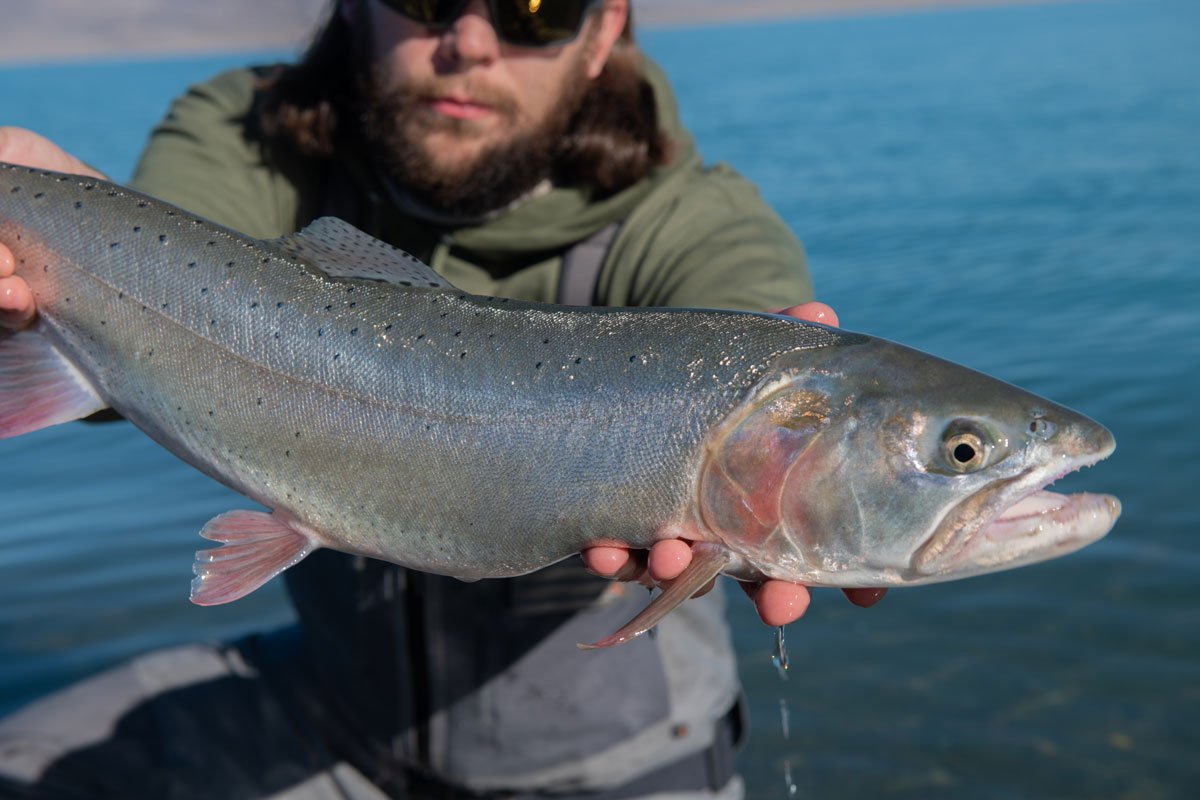Part 2 – Pyramid's Lahontan Cutthroat Trout

Part 2 of our series on Fishing Pyramid Lake
The Lahontan Cutthroat trout is a sub-species of the family of Salmonid and is currently one of 3 species listed federally threatened. They are in the genus Oncorhynchus which covers all pacific trout species. These fish where believed to move up from the ocean via the Colombia and Snake river drainage 3-5 million years ago and over time became geographically isolated during the last ice age where they evolved to become the distinct sub-species of Lahontan cutthroat trout residing in Lake Lahontan. This is where they resided until the end of the Pleistocene era where their native range shrunk into a few waterways including Lake Tahoe, Walker Lake, Pyramid Lake and their connecting lakes and tributaries. The world record Lahontan Cutthroat was caught in Pyramid Lake by Johnny Skimmerhorn in 1925 weighing 41 pounds. It was believed that at one time fish weighing over 60 pounds where swimming in these waters.

As mentioned before these fish suffered from over-harvesting, introduction of dams and mismanagement of water as well as introduction of non-native species of fish until they finally got their designation of a federally threatened species in 1975. Undoubtably, the biggest advocacy for these fish came from the tribes living on the Pyramid Lake Reservation. These trout are, and continue to be, the livelihood of these tribes as the fish’s roll shifts from a primary food source to the main monetary source through a sustainable sports fishery. They tirelessly work to reestablish the populations of trout in this lake through a major stocking program with hatcheries located on the reservation. They also are constantly pursuing conservation through legal actions to ensure an allotment of water out of the Truckee river.
The Reintroduction of Lahontan Cutthroat Trout
After the Pyramid Lake cutthroats initial extinction in 1943, the tribes attempted to reestablish a population of cutthroat through a stocking program using a cutthroat from nearby Summit Lake. However, these fish had a number of concerning differences. They did not live as long, grow as large nor have the propensity to reproduce in the conditions found at Pyramid Lake. This made the fishery heavily reliant of stocking to bolster the populations of these fish as natural propagation was non-existent. The silver lining of this story comes in the 1970’s when scientists discovered a population Lahontan cutthroat in a small headwater stream along the border of Nevada and Utah outside of their geographic range. It wasn’t until the 1990’s when technology was good enough to positively identify these cutthroat as originating from Pyramid Lake. They were believed to be stocked by a wildlife commission predating the Fish and Wildlife Service we know today. Stocked via trains, they spread these fish all over northern Nevada and parts of Utah. A majority of the fish where stocked in waters with other fish species. The creek in the Pilot Peak area was previously barren of fish however which kept these fish genetically isolated upon their rediscovery in the 1970’s. After genetic confirmation of these fish, the U.S. Fish and Wildlife Service and the Pyramid Lake Paiute tribe began to work on reintroducing these fish to their once native range in 2006. Now, in just a span of 15 years, these fish have starting to reach their historic size and catching a fish around 20 pounds is common, while it’s just a matter of time before we see a 30 pound fish caught.

With the introduction of the new fish screen at Derby Dam, the return of these fish along the banks of the Truckee River is highly likely. The Pilot Peak strain of cutthroat is reported to be making its way back up the Truckee River in large numbers in an attempt to spawn. This means that natural propagation of these fish is a realistic possibility and furthermore the Truckee River could see a spawning run not seen here in over 100 years. While this is certainly an incredible story of the perseverance, these fish we still have a lot of work to do. The lower section of river remains dewatered due to high water demand from businesses and agriculture in the greater Reno area, it has a number of “dead beat dams” which restrict free passage of these migratory fish and is grossly polluted with little suitable spawning habitat until they get west of Reno. If there’s anything this story has told you thus far though, never say never! We as a people need to help advocate for conservation, preservation and rehabilitation of the Truckee River if we ever want to see these fish return to their natural, historic range.
Read Part 3 of the Series
Back to Pyramid Lake Page






